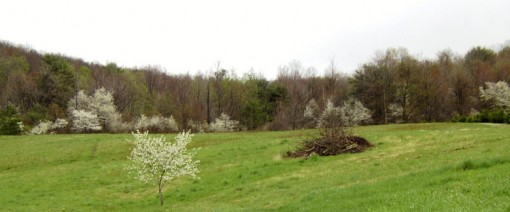 I spent my childhood in climates where the flowering dogwood (Cornus florida) flourished, and I loved its elegant simplicity. When we moved here, I was dismayed but not surprised when my new neighbor told me that she had twice planted a flowering dogwood in a protected corner of her house, and twice it had died. Having just endured my first thirty-degrees-below-zero-Fahrenheit winter, no, I was not surprised.
I spent my childhood in climates where the flowering dogwood (Cornus florida) flourished, and I loved its elegant simplicity. When we moved here, I was dismayed but not surprised when my new neighbor told me that she had twice planted a flowering dogwood in a protected corner of her house, and twice it had died. Having just endured my first thirty-degrees-below-zero-Fahrenheit winter, no, I was not surprised.
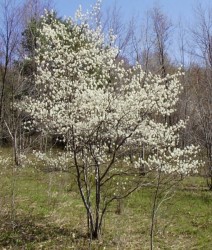 But I was surprised to discover a tree that has much of the grace of the dogwood, with a decidedly stronger constitution: the Juneberry (Amelanchier species). A member of the rose family, it is a cousin to the apple clan but blooms before them, usually about a week before the forest canopy leafs out, when the emerging leaves are but a confetti of yellows, reds, and greens. An American native, it evokes the Japanese garden in the elegant structure of its branches and the ephemeral, fleeting nature of the blossoms.
But I was surprised to discover a tree that has much of the grace of the dogwood, with a decidedly stronger constitution: the Juneberry (Amelanchier species). A member of the rose family, it is a cousin to the apple clan but blooms before them, usually about a week before the forest canopy leafs out, when the emerging leaves are but a confetti of yellows, reds, and greens. An American native, it evokes the Japanese garden in the elegant structure of its branches and the ephemeral, fleeting nature of the blossoms.
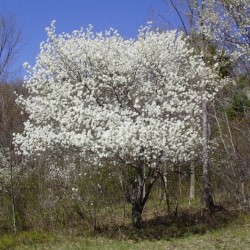 We have become something of Juneberry connoisseurs and are more sensitive to individual differences. This one on the right has consistently whiter and more floriferous blossoms. Even from the house, at the bottom of the hill, it glows like a beacon, drawing us up into the woods.
We have become something of Juneberry connoisseurs and are more sensitive to individual differences. This one on the right has consistently whiter and more floriferous blossoms. Even from the house, at the bottom of the hill, it glows like a beacon, drawing us up into the woods. 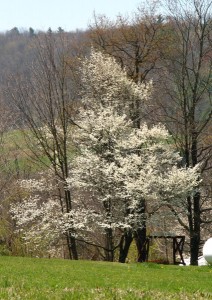 Others (such as below) are more upright, drawing the eye to the spring sky and the canopy on the brink of emerging.
Others (such as below) are more upright, drawing the eye to the spring sky and the canopy on the brink of emerging.
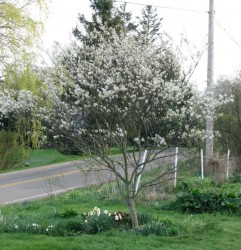 It’s a bit like bringing coals to Newcastle, but I became so enamored with these unassuming trees that I searched out Amelanchier ‘Autumn Brilliance’ to plant as a landscape tree near the house, seduced by catalog copy promising larger and more plentiful flowers and spectacular autumn foliage (pictured below left). This is a hybrid of two species, Amelanchier canadensis and Amelanchier laevis. The leaves do turn spectacular shades of orange–one at a time, from the bottom of the canopy up, starting in August–and it is one of the first trees to be completely denuded. I don’t know if this is normal behavior or not, but it is consistent, and the tree doesn’t otherwise seem to be under stress. Its one advantage is that it blooms a good week later than all its native-born sisters up the hill. All in all, it doesn’t seem to be enough of an improvement that I would go out and spend money on another one. I’d be more inclined to try to propagate that especially brilliant white one, wouldn’t you?
It’s a bit like bringing coals to Newcastle, but I became so enamored with these unassuming trees that I searched out Amelanchier ‘Autumn Brilliance’ to plant as a landscape tree near the house, seduced by catalog copy promising larger and more plentiful flowers and spectacular autumn foliage (pictured below left). This is a hybrid of two species, Amelanchier canadensis and Amelanchier laevis. The leaves do turn spectacular shades of orange–one at a time, from the bottom of the canopy up, starting in August–and it is one of the first trees to be completely denuded. I don’t know if this is normal behavior or not, but it is consistent, and the tree doesn’t otherwise seem to be under stress. Its one advantage is that it blooms a good week later than all its native-born sisters up the hill. All in all, it doesn’t seem to be enough of an improvement that I would go out and spend money on another one. I’d be more inclined to try to propagate that especially brilliant white one, wouldn’t you?
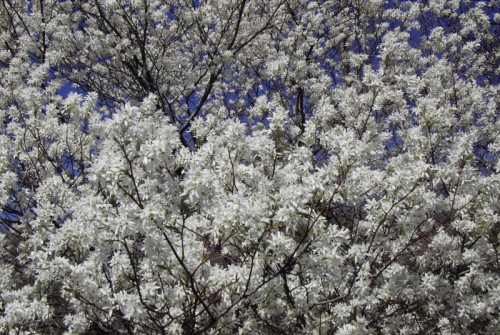




Kathy, this is lovely. I fell hard for these, too, and was DELIGHTED to find them growing all over our Chicago neighborhood, together with another favorite, redbuds! There is even one spot near the lake where you can get enough distance to see their white glory against the other trees yet to leaf out. Thery are all much smaller than any I saw in a hedgerow, likely cultivars. I’ll take ’em!
I am glad you have Juneberries in your new home, Lynn! I think I wrote that Juneberry post before you moved to Slaterville Springs. The redbuds aren’t quite as hardy, that probably means you have a broader palette of plants to work with now.
You are right, Kathy. But I couldn´t find the Latin name either. 🙂
Perhaps there is a website I don´t yet know about?
A Canadian friend sent me this link, because I never could find out how my “Felsenbirne” is called in English. Now I got to know even several names of it! My juneberry is my favourite of all the trees and bushes in my small garden. Last but not least because of its tasty berries which had been mentioned by some posters. I share them with the birds, they eat the upper part while I pick the lower storey – it is a peaceful coexistence since many years.
Firefly, perhaps a good advice: The Juneberry grows reliably in a loamy soil. I have just learned that it is a member of the rose family, so it is no wonder that it loves loamy ground! And yes, plant it now, in the springtime!
Best wishes from Germany.
Gabi
Now I know how to pronounce Juneberry in German! Thank you, Gabi. This is one case where knowing the Latin name of a tree would help you find its name in other languages.
We have a secret weapon to keep birds from eating all the serviceberries…many mulberry trees in the neighborhood. The birds seem to prefer mulberries over any other kind of fruit so even if our serviceberries are in the black ripe stage the birds rarely touch them and I can pick as many as I want or I am willing to pick. We freeze the juneberries until the blueberries ripen about a month later. Unfortunately by that time the mulberries are about done, so I have to fight the cowbirds and catbirds for the blueberries!
Ki–we grow blueberries here but they aren’t ripe in June, when the Juneberries are. Do you put some sort of netting over your Juneberries, or is there enough for you and the birds to share?
I love serviceberry trees as an ornamental and for its delicious fruit especially in a mixed blueberry, service berry pie!
Several of our serviceberries sucker freely and I noticed that the suckers form roots of their own so I cut off the suckers near the mother plant, retaining as much of the roots as possible, stuck it in some rooting hormone and placed it in some perlite. I placed a plastic tent over the suckers to prevent dessication but all the leaves fell off anyway but it may have prevented drawing off moisture from the stems. About 1/2 of the suckers lived and were planted in the yard after a couple of month when new leaves formed and are thriving. So if you have suckering serviceberry and want more this is a fairly easy method to propagate the plant.
The trees I have are probably A. arborea but I don’t really know as they didn’t have an identification tag on them.
I agree, Firefly, don’t give up. It was a weird winter. Maybe planting in spring would help? My ‘Autumn Brilliance’ came all the way from Idaho (back in the pre-internet days when I didn’t know about St. Lawrence), bareroot, and managed to get established.
I envy you these trees. I planted three A. arborea seedlings last year that didn’t make it through the winter. Maybe even through the planting process. There was clay and compost in the seedling pots and I had such a hard time dislodging the plants that the rootballs fell apart. Apparently that was enough — or maybe that and the winter we had, I don’t know.
Nil desperandum. I’m planting more. I’ve always wanted flowering trees.
Ro, St. Lawrence makes it sound like they are pretty easy to please. As you know, my soil is acid clay, and while I am sure I added some sort of organic soil amendment when I planted it, I am also sure it wasn’t enough to make it ideal. I’ve never babied it during droughts, either, and it’s done fine.
I have seen saskatoons offered in the St. Lawrence Nurseries catalog. We’ve never tried to compete with the birds for the fruit. Our soil is acid enough to grow blueberries without needing amendment, so I wonder if the saskatoons would fare as well. You do make them sound appealing.
I’m partial to Amelanchier alnifolia, what we call the saskatoon berry (I’ve also seen it called serviceberry). Pretty flowers (although not as spectacular as your Juneberries above), Tasty fruit (mmm, saskatoon pie, mmmm), good autumn colour, hardy to at least zone 2, and there are cultivars that don’t sucker… much. I only have one but they grow wild here. If I ever take out the spruce in my front yard, I plan to put in a hedge of saskatoons. I may also replace the old lilac in my back yard, which suckers horribly into my patio, with a saskatoon.
I just bought “Princess Diana” from St. Lawrence nursery. I previously had an “Autumn Brillance” but it lost its life to a weed wacker. This is small, and I would like to know what conditions would make it happy, or if anyone can recommend companions. It is also a grandiflora.
I don’t know if it is premature leaf drop, but I think this is one of the first trees to lose its leaves in the fall. Mine is a A. x grandiflora, but I don’t know if it is the variety named “Autumn Brilliance”. I can’t find the tag!
I have a several reference books on trees, from my college days, but they are 25 years old, or older and so a bit out of date when it comes to newer hybrids and named varieties of trees!
Jenn, thanks for the link. My first thought was to see if layering was feasible, as Juneberries are often suckering.
Carol, I did a little research and am more confused than ever. I only have one reference book that covers trees, and that’s the AHS A-Z Encyclopedia of Garden Plants. It says the Apple serviceberry is a hybrid of A. arborea and A. laevis, and it’s referred to as A. x grandiflora. It also says ‘Autumn Brilliance’ is a named cultivar of this hybrid. The information in my post was taken from a web page found through a google search. I do know that there is disagreement about exactly how many species there are in this genus, and how to distinguish them. Our two Juneberries are probably pretty similar, if not the same plant. Have you noticed premature leaf drop in the fall?
Seems like that would be a perfect tree to try hardwood cuttings on.
I have an Apple Serviceberry. It is a hybrid. I’m not sure of which two species. It has stayed quite small, but otherwise has good blooms, good summer foliage, and decent fall color.
If you see a better tree than what you bought, I would try to propogate it. Maybe it would be enough different that you could give it a name like ‘Kathy Purdy’.